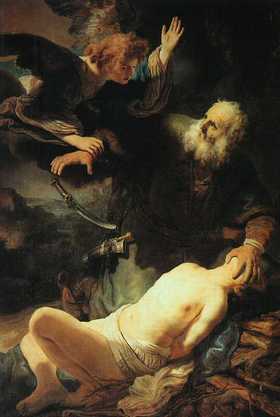In the early eighteenth century Britain’s first prime minister, Sir Robert Walpole, assembled a large and extremely good collection of art and antiquities. After his death hopes were expressed that it might be acquired for Britain and used as the foundation for a national gallery, but in 1779 Sir Robert’s grandson, George Walpole, sold off the bulk of it – consisting of 204 works of art – to Catherine the Great of Russia. The collection subsequently entered the State Hermitage Museum in St Petersburg, where it has remained ever since – until yesterday, that is, when a selection of these masterpieces went on display at the Hermitage Rooms at Somerset House. This week’s picture is one of them: Abraham’s Sacrifice, a large and dramatic biblical scene by Rembrandt.
According to a late eighteenth-century inventory of the Walpole sale this particular picture was valued at £300 when Catherine the Great bought it. That seems cheap now but at the time was regarded as a great deal of money to pay for a painting. Horace Walpole, Sir Robert Walpole’s youngest son, clearly regarded Abraham’s Sacrifice as one of the jewels of the family collection. “Abraham’s head, and the naked body of Isaac, are very fine,” he wrote, also noting with approval that “the painter has avoided much of the horror of the story, by making Abraham cover the boy’s face.”
Rembrandt painted the picture in 1635, a few years after moving to Amsterdam, where he was in great demand as a portraitist. Abraham’s Sacrifice was one of a number of ambitious narrative pictures, done on a grand scale (the figures are life-size), intended to prove that he could be more than just a talented painter of well-to-do Dutch burghers and their wives. Rembrandt wanted to show that he could tackle...


